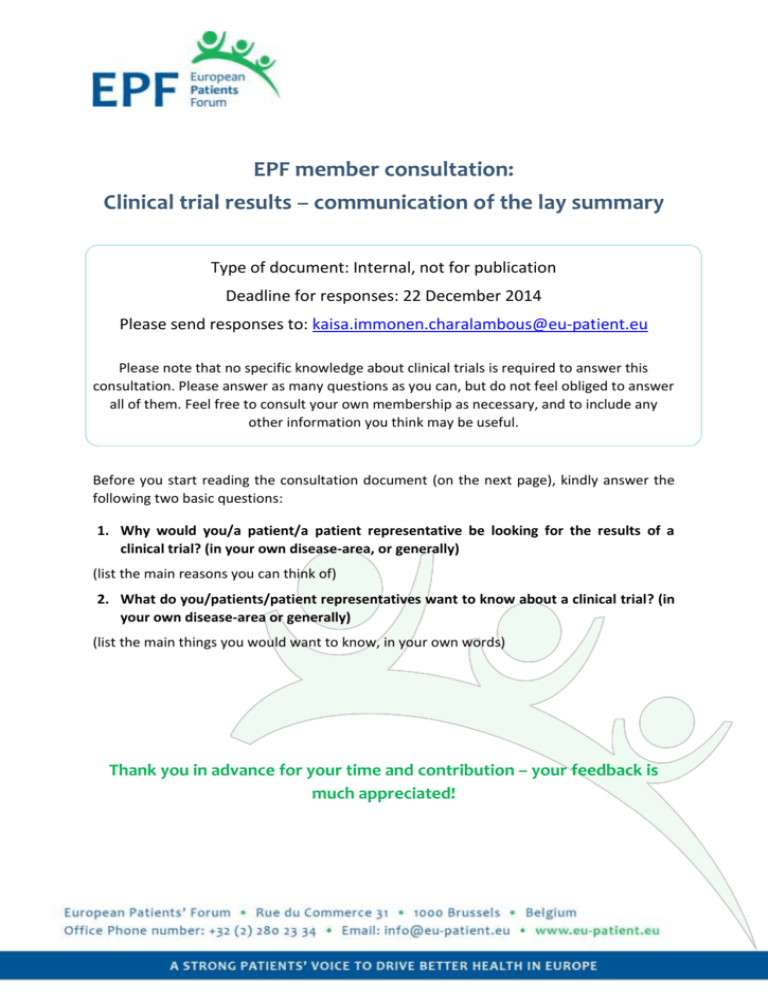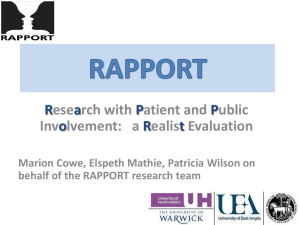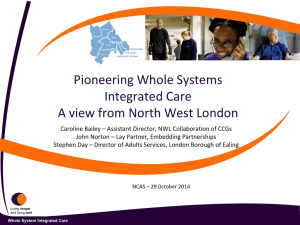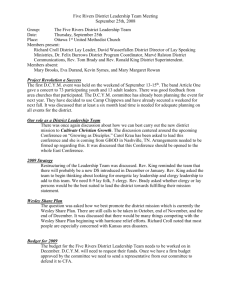lay summaries - European Patients` Forum
advertisement

Type of document: Internal, not for publication Deadline for responses: 22 December 2014 Please send responses to: kaisa.immonen.charalambous@eu-patient.eu Please note that no specific knowledge about clinical trials is required to answer this consultation. Please answer as many questions as you can, but do not feel obliged to answer all of them. Feel free to consult your own membership as necessary, and to include any other information you think may be useful. Before you start reading the consultation document (on the next page), kindly answer the following two basic questions: 1. Why would you/a patient/a patient representative be looking for the results of a clinical trial? (in your own disease-area, or generally) (list the main reasons you can think of) 2. What do you/patients/patient representatives want to know about a clinical trial? (in your own disease-area or generally) (list the main things you would want to know, in your own words) Thank you in advance for your time and contribution – your feedback is much appreciated! The new EU Clinical Trials Regulation (Regulation 536/2014) introduces a number of improvements to the transparency of clinical trial results: compulsory registration of all trials principle of public access to the EU clinical trials database developed and maintained by the European Medicines Agency publication of all trial results, irrespective of the outcomes, on the EU database summary results must include a summary “understandable to lay person”. The summary results, including the lay summary, will be published within one year after the end of the trial, irrespective of the outcomes of the trial. If it is not possible to submit the summary results within one year, this can be delayed but only for scientific reasons; which must be justified in the protocol. In such a case the protocol must say when the results will be published.1 Patients participating in a trial must be told that a lay summary of the results will be available on the EU database, and they should also be told when the summary results will become available, as far as that is already known (Article 29 (6)). In order to achieve meaningful patient involvement in research, it is crucial that at every stage of the research process, information is available to patients in a way that enables them to understand it. So-called “lay summaries” are needed for example at the stage of seeking funding and ethics approval, and they are important not only for patients but also for lay persons and non-specialist medical professionals. The summary may need to be to be drafted differently according to its purpose and target audience. The lay summaries that will be published on the EU database are only one type of lay summary: they are intended for the general public, including patients, who seek information about the results of a specific trial. Currently, some published research includes a lay summary, but these are of variable quality, and there is no single agreed standard for producing summaries.2 1 This consultation deals only with the lay summary. However, if a clinical trial is done with the aim of gaining a marketing authorisation in the EU, then the clinical study report (CSR) must also be published. This happens 30 days after the completion of the assessment procedure. (Article 37 (4)) the clinical study report is therefore published substantially later than the summary results, because of the time needed to conclude the assessment procedure. The CSR must be published regardless of the outcome of the application (approval, rejection, or withdrawal). 2 Denegri and Faure (2013)."It’s plain and simple: transparency is good for science and in the public interest." Trials 2013, 14:215. 2 EPF consultation document – lay summary of clinical trial results – November 2014 If the EU database is to become the main point of reference for patients for information about clinical trials, then it needs to establish a high standard of patient-friendliness for the information that is presented, the way it is presented, and the user experience of the electronic interface. Summary results should be communicated in a way that is unbiased, comprehensive, relevant, and understandable to patients. A set of “core quality principles” for information to patients was developed by the High-Level Pharmaceutical Forum (2008) and endorsed by Member States. These principles are general criteria intended to be applicable to all kinds of information to patients. They include criteria relating to the evidence base, factual correctness, source and verifiability of information; criteria to check information is focused on issues that patients consider important, ideally with patients’ involvement; and criteria to check information is understandable by lay persons and accessible to everyone.3 EPF RECOMMENDATION: EPF calls for a set of guidelines to be developed at EU level, with the involvement of patient organisations, to ensure that the lay summaries written for the EU database adhere to a common set of quality standards. The existing core quality principles could be used as a starting point. In addition, existing guidance on lay summaries should be reviewed and used to arrive at the common set of guidelines. The process should take into account the fact that the lay summaries will eventually be translated into all EU languages, whilst available guidance is mostly in English. QUESTIONS TO MEMBERS: 3. Do you agree with this recommendation? 4. What form should the process take? a. a working group hosted at EMA with patient representatives, European Commission, regulators and industry? b. a European wide consultation process coordinated by the European Commission ? c. other? The content of the summary is set out in Annex V of the Clinical Trials Regulation.4 However, this is only a list of elements the lay summary must contain. It says nothing about how, or in how much detail, they should be described. This list was added by the Council at the last stage 3 http://ec.europa.eu/enterprise/sectors/healthcare/files/docs/itp_quality_en.pdf The Regulation in all EU languages is available here: http://eur-lex.europa.eu/legalcontent/EN/TXT/?uri=uriserv:OJ.L_.2014.158.01.0001.01.ENG 4 3 EPF consultation document – lay summary of clinical trial results – November 2014 of negotiations, without any consultation with patient groups. It is therefore far from clear how the list of items in itself will meet patients’ information needs. On the next page you will see the elements listed in Annex V. We have added some items that we feel are missing from the list. Please look at the least and see if you agree with EPF comments, and let us know if you would like to add some other items to this list. Annex V of the Regulation specifies the following information: i. Clinical trial identification (including title of the trial, protocol number, EU trial number and other identifiers); ii. Name and contact details of the sponsor; iii. General information about the clinical trial (including where and when the trial was conducted, the main objectives of the trial and an explanation of the reasons for conducting it); iv. Population of subjects (including information on the number of subjects included in the trial in the Member State concerned, in the Union and in third countries; age group breakdown and gender breakdown; inclusion and exclusion criteria); v. Investigational medicinal products used; vi. Description of adverse reactions and their frequency; vii. Overall results of the clinical trial; viii. Comments on the outcome of the clinical trial; ix. Indication if follow up clinical trials are foreseen; x. Indication where additional information could be found. EPF recommends that at least the following information should be added: xi. What end points were used and why – perhaps to be included under point 3. xii. Limitations of the study, how potential sources of bias and imprecision were addressed, and caveats – we note that this is included in Annex IV (summary results) but not in Annex V – yet it is equally important for lay readers!) This could be included under point 8, but perhaps it is better addressed as a separate heading. xiii. Substantial modifications and protocol changes made along the way – perhaps to be included under point 3. QUESTIONS TO MEMBERS: 5. Do you agree with EPF’s suggested additions? 6. Do you wish to add any other points? The next section looks at these categories of information in more detail. 4 EPF consultation document – lay summary of clinical trial results – November 2014 Please look at each of the categories of information specified by the regulation, and tell us: what you would like to know in each category; how this should be described; and any other comments. If you prefer, you can go directly to the next section which deals with general principles about how information should be communicated. e.g. is there something specific that should be mentioned under each category? How would you expect for example “investigational medicinal products” or “adverse reactions” section to be described? Are any of the categories not clear? Are there some key terms (“jargon”) that should be explained? Category of information (as described in the Regulation) Your comments General information about the clinical trial (including where and when the trial was conducted, the main objectives of the trial and an explanation of the reasons for conducting it) Population of subjects (including information on the number of subjects included in the trial in the Member State concerned, in the Union and in third countries; age group breakdown and gender breakdown; inclusion and exclusion criteria Investigational medicinal products used Description of adverse reactions and their frequency Overall results of the clinical trial Comments on the outcome of the clinical trial Indication if follow up clinical trials are foreseen Indication where additional information could be found e.g. link to other clinical trial registries? What end points were used and why Limitations of the study, how potential sources of bias and imprecision were addressed, and caveats Substantial modifications and protocol changes made along the way 5 EPF consultation document – lay summary of clinical trial results – November 2014 Information will only be understandable if it is presented in a patient-friendly language and format. Moreover, it should be relevant to patients’ information needs. However, the Regulation gives no guidance as to how the information contained in the lay summary should be written. Indeed, there is relatively little research on this, although some guidance is available at least from the UK.5 Some issues that we feel need to be addressed are described below, including some questions. Please feel free to provide comments. User-friendliness of the electronic interface There is need for guidance within the EU database, including a glossary of key terms. Many words commonly used in clinical trials reporting are not understood by all patients (such as “efficacy”, “endpoint”, “surrogate“...). Some glossaries targeted at patients are already available, although they may not include all terms.6 The layout of the electronic interface needs to be intuitive and user-friendly. EPF RECOMMENDATIONS: The EU database should have an integral glossary that is simple and easy-to-use on the electronic interface, for example by “hovering” mouse over a word. Existing patient-friendly glossaries can be used as guidance. Do you agree? What else is needed to make an easy-to-use electronic database? Can you think of any examples of good website design? Ensuring a summary is written for lay persons To write a good lay summary is not simple and requires a specific skill, but this is often not recognised. A survey in 2012 by BioMed Central found that 79% of the researchers did not involve lay people, and the same percentage either would not pay or did not know whether they would consider paying for professionally written lay summaries.7 The European database will be available in all EU languages. When lay summaries are translated (usually from English) into other languages, there may be quality issues to consider to ensure that the summary remains reader friendly. Patients could play an important role by being involved in the development of the summary – this could be relatively easy when patients are closely involved in the research itself – or in reviewing lay summaries. 5 http://www.dcc.ac.uk/resources/how-guides/write-lay-summary ; http://www.invo.org.uk/wpcontent/uploads/2013/03/Improving-quality-of-plain-English-summaries-report-final.pdf ; 6 EGAN-Roche: http://www.biomedinvo4all.com/en/research-themes/clinical-trials/clinical-trial-glossary . Clinicaltrials.gov has a glossary: http://clinicaltrials.gov/ct2/about-studies/glossary. The EU clinical trials register has a glossary in PDF format that could be reviewed: https://www.clinicaltrialsregister.eu/doc/EU_Clinical_Trials_Register_Glossary.pdf 7 Denegri and Faure (2013) 6 EPF consultation document – lay summary of clinical trial results – November 2014 EPF RECOMMENDATIONS: The lay summary should be written by …. The content of the summary should be checked by patients to ensure it is comprehensive and understandable. How? Who should write the lay summary? Who should check it is truly lay-friendly? What do you think is the most practical way of involving patients in lay summaries? What support would be needed? Trustworthiness Conveying scientific information, especially where the interpretation of results may depend on some quite nuanced details, into simple language that a non-medical person can understand, is not easy and can risk coming across as biased, even with the best intentions. In addition to easy understanding, there may be concerns about the factual accuracy of summary results, given that summarising always involves simplification. Summaries will most likely be written by the pharmaceutical companies or academic institutions that conduct the research, which could risk introducing bias (even unconsciously) into the communication. However, neither the European Medicines Agency nor the Member States’ authorities have adequate resources to check every summary. Who should check the reliability and accuracy of lay summaries? Do you know of any good examples? Empowering patients through ‘scientific literacy’ Patients will be more empowered to judge for themselves whether a summary of results is trustworthy when they know how to interpret clinical trials results. This means that patients should be able to understand the main principles and concepts of trial design and conduct, especially how to assess the evidence, and potential sources of bias. Some useful resources exist to make scientific concepts understandable to the general public. For example, a good guide written in simple language for lay people is Testing Treatments (2nd edition, 2011) available online in an interactive website format in multiple languages, as well as PDF book free of charge.8 Do you have any comments regarding what kind of educational materials are needed for patients to understand trial results? Are you aware of any good tools, particularly nonEnglish? Are you aware of any patient organisations’ involvement in communicating results of clinical trials in simple language? Do you have any other comments? 8 Testing Treatments interactive: www.testingtreatments.org; at least part of the content is also available in other languages, including French, German, Italian, Spanish, Croatian and Turkish. 7 EPF consultation document – lay summary of clinical trial results – November 2014 Any comments you can provide, no matter how brief, will be valuable and much appreciated! Based on the feedback received from you, EPF will develop a position statement. We will circulate the position statement again for final comments before formal adoption. Thank you very much for your time! 8 EPF consultation document – lay summary of clinical trial results – November 2014









